HUMAYUN TOMB
Table of Contents
INTRODUCTION
Humayun Tomb or Taj of Delhi is a gigantic red and white stone’s mausoleum. Importantly, it is the first big Mughal construction in India. Although there are many tourist places in Delhi, this particular monument has the charm to attract millions of visitors. Surprisingly, It has no calligraphy, but still, the red and white contrast is enough to make you fall in love.
Arguably, Haji Begum, wife of Emperor Humayun, built it. Still, some historians believe it was Akbar who ordered the construction. Interestingly, they started it in 1565 and completed it in 1572. Mirza ghiyas beg a Persian architect who designed it.
Moreover, William Finch, who visited the tomb those days, wrote something special. There were rich paintings on the wall of the central hall, and carpets were on the floor. On the top of the grave, there was a tent of a white sheet, and they put his sword, shoes near it.
HUMAYUN TOMB TIMINGS
SUMMER : 7:00 MORNING TO 6:00 EVENING
WINTER : 7:00 MORNING TO 5:00 EVENING
HUMAYUN TOMB TICKET
ENTRANCES: INR 40/- INDIAN INR 600/- FOREIGNERS
HUMAYUN TOMB ARCHITECTURE

It is not just a tomb but a big complex. Undoubtedly, this place has its history because before building a tomb, there were other structures too. The main attraction point is the main Humayun tomb, red and white. Certainly, After reading this blog, you will learn about Mughal art and architecture.
ENTRANCE GATES
If you go to any Mughal building, you will find more than one entrance. Surprisingly, for mosques and tombs, there are three entrances. They built them for the public to give access in every direction. Certainly, in Humayun’s tomb, there are three entrances and one baradari facing river Yamuna.
Moreover, Two entrances are closed among three, only one is opened. You will go to the tomb from the Sabz Burj circle. The Humayun tomb complex is divided into four sections. First is ISA KHAN TOMB AND MOSQUE. Second, BU HALIMA TOMB AND GARDEN. Third, AFSAR WALA TOMB AND MOSQUE. Fourth is HUMAYUN TOMB. Interestingly, there is a huge benefit to entering from this side because you will see everything in sequence.
FOUR GAEDEN PLAN
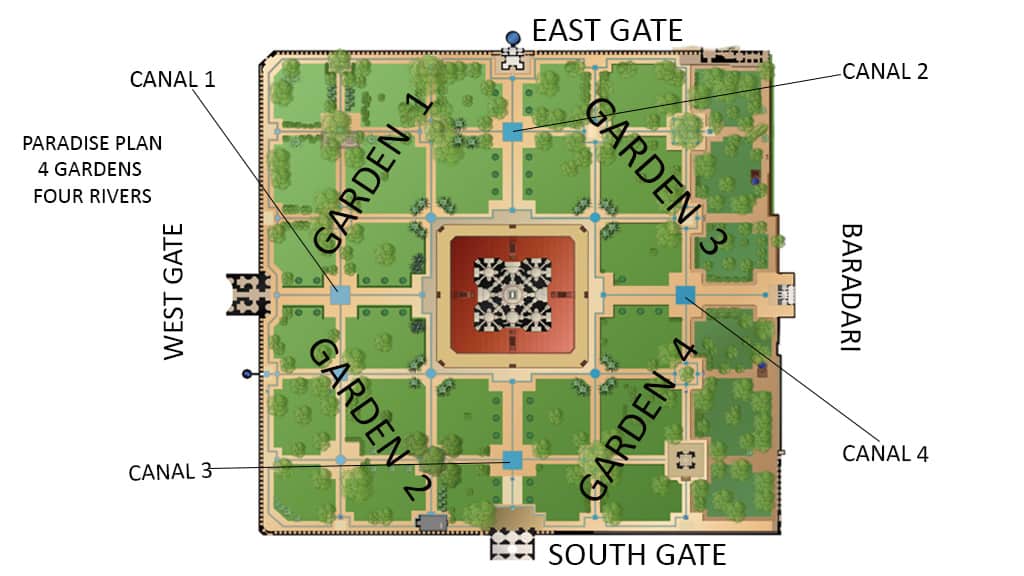
The Mughal dynasty came from Samarkand (Uzbekistan). In Central Asia, the weather is completely different from India, and local rulers always built pleasure gardens there to enjoy. Surprisingly, when Babur came to India, he did not find any garden, and hence, he started building gardens here.
Interestingly, during building the Humayun tomb, this garden feature was used as a paradise plan. Do people always ask what paradise plan is? In Noble Quran, you can find a garden description with rivers. Hence, Artists used the same features to build it, and later they also used the same feature to build the Taj Mahal.
The four garden plan is quite simple to understand. There are four water canals with fountain tanks in (plus shape). Moreover, Three water canals lead towards the main tomb from three gates and the fourth canal from baradari to the main tomb. Apart from this, the plus shape water canals with a tomb in the center divide the garden into four parts. Each garden has eight small parts.
MAIN TOMB EXTERIOR
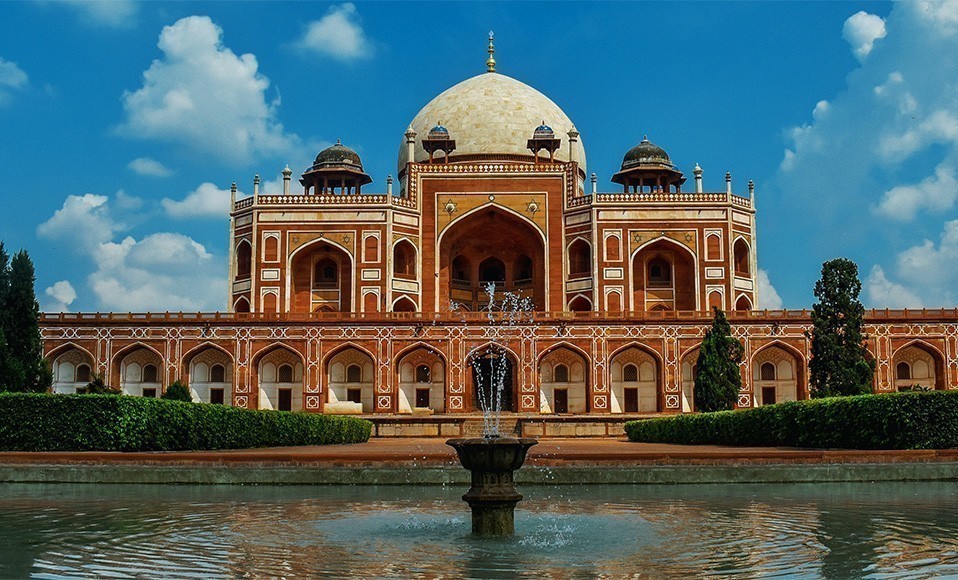
The main attraction of the Humayun tomb is the red and white building in the center. Undoubtedly, there is no Arabic design and inlay art like the Taj Mahal. Still, a red stone with marble is remarkable. They used some blue tiles on chhatris and yellow stone to beautify it. Notably, I have divided the tomb into three parts to make you understand. Platform, Central octagonal structure, and dome.
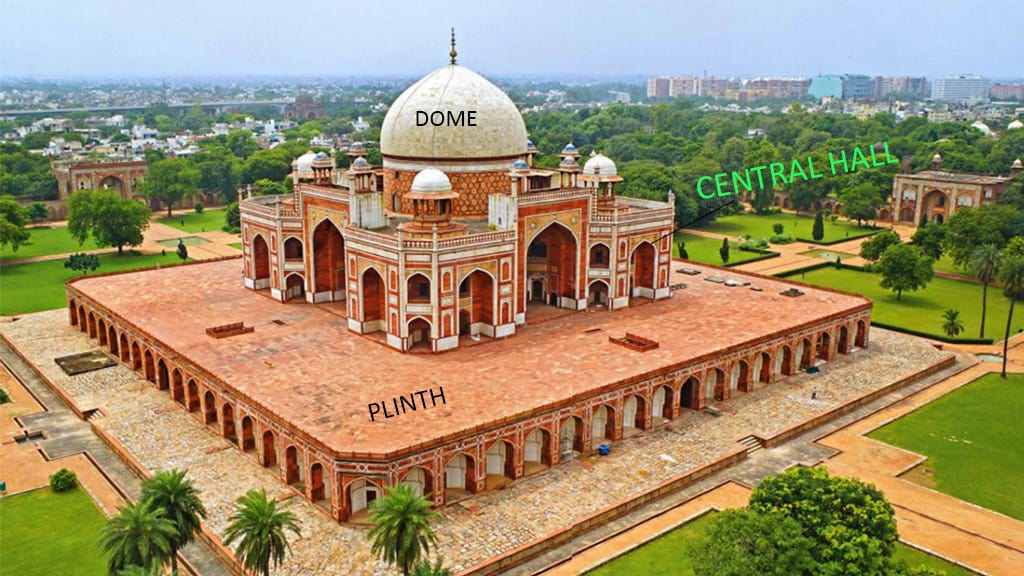
PLATFORM (PLINTH): The first thing is to watch is a red and white plinth or platform. This huge red sandstone plinth is around 6.5 meters high. If I talk about the size, it is 45 X 45 meters, and the shape is octagonal. Interestingly, on Each side 17 small arches (8 arches on the left in center stairs, 8 arches on the right). Moreover, they used white marble to decorate it and made geometry also.
FAKE GRAVE AND REAL GRAVE? Mughal always made two graves real fake. Notably, the real grave is below the plinth, and the fake is on the plinth. Interestingly, the fake was for the public and real for the Royal family. Importantly, we can not see the real grave of Humayun tomb, which is closed. People bury human bodies on the ground, not on the roof.
CENTRAL HALL EXTERIOR: The second thing is the central hall, also octagonal. It looks so beautiful without any deep decoration. Importantly, it is a two-story structure with four big arches on every side. On the left and right, there are small arches also. If I talk about the decoration, they made stars on every big arch with a lotus flower in the center. Moreover, they also used yellow stone, Black marble, White marble, Blue and green tiles.
Without a doubt, the most beautiful thing to watch here is Jalis (windows), which are at the bottom of every big arch. They cut one huge white marble slab and made geometry.
DOME AND DRUM: On the top of the central hall, there is a huge white marble double dome with the drum. Now many people ask, what is a drum? The answer is simple drum is a round neck just below the dome. Surprisingly, they built drums just to give height to the dome. You can see the drum in the pic above.
Moreover, If I talk about dome height, it is 42.5 meters. They used white marble to decorate it. On the top, there is gold coated finial of 7 meters. To decorate the red drum, they made stars and other geometry.
HUMAYUN TOMB INSIDE
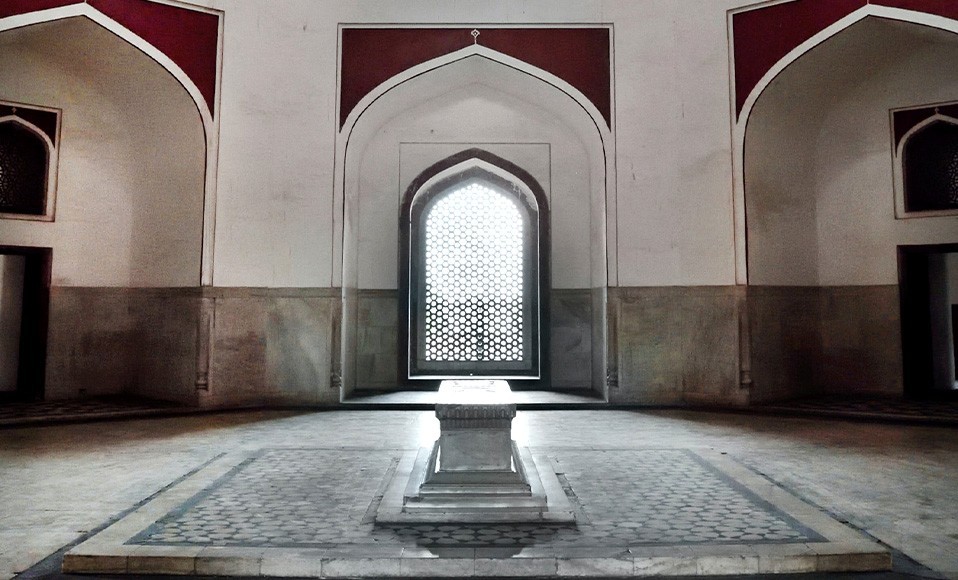
The main central hall from inside is octagonal, and there is a white marble tomb of Emperor Humayun. There is no calligraphy of Arabic on the grave. Interestingly, there was a white sheet tent on the grave, and the sword and shoes of Humayun were there. Earlier, multicolor paintings were everywhere inside the central hall; sadly, it does not exist now. In Addition, the base of the main grave is also decorated with stars of black marble. You can see the design of the main hall is two-story.
Moreover, the main central hall is surrounded by four small octagonal halls at every corner. You can find graves of the Mughal family with calligraphy and flowers design. Interestingly, there is an unmarked grave of Dara Shikoh (Brother of Aurangzeb) in one of the small octagonal rooms. The most considerable feature of the hall of Humayun tomb is the windows (jali).
JALI WORK
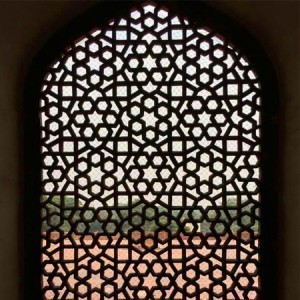
Emperor Humayun was living in Persia during his exile. He
learned many things there, but two arts he brought in India are paintings and architecture. Certainly, in the Humayun tomb, there is a lot of Persian influence.
Without a doubt, every monument has its specialization; in the Humayun tomb, it is windows (jalis). Surprisingly, they used one piece of stone to carve these beautiful windows, and some were red stone and other white marble. As usual, they made stars and other geometrical designs. The most beautiful window is in the west of the central hall, and Interestingly, it has a star in the center.
WHO BUILT HUMAYUN TOMB?
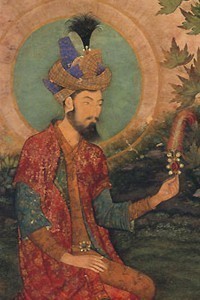
Mughal empire started ruling in India when they defeated Lodhi in the battle of Panipat in 1527. Babur was the founder of the dynasty, and Humayun was his son. After the death of Babur, Humayun took charge and started ruling. Further, He built a new city in Delhi, named it (Dinpanah) Purana quila.
Unfortunately, Afgan ruler Shershah Suri defeated Humayun around 1540. As a result, Humayun left India; He had no choice but to live in Persia. After spending 15 long years once again, Humayun came to India with the help of King of Persia Shah Tehmash. Shershah Suri had died, and the situation was favorable. He took advantage and started ruling again.
Second Mughal Emperor Humayun died in 1556, just one year after his second arrival to India in 1555. Notably, later his son Jalal Uddin took the throne and gave himself the title of Akbar.
ISA KHAN TOMB
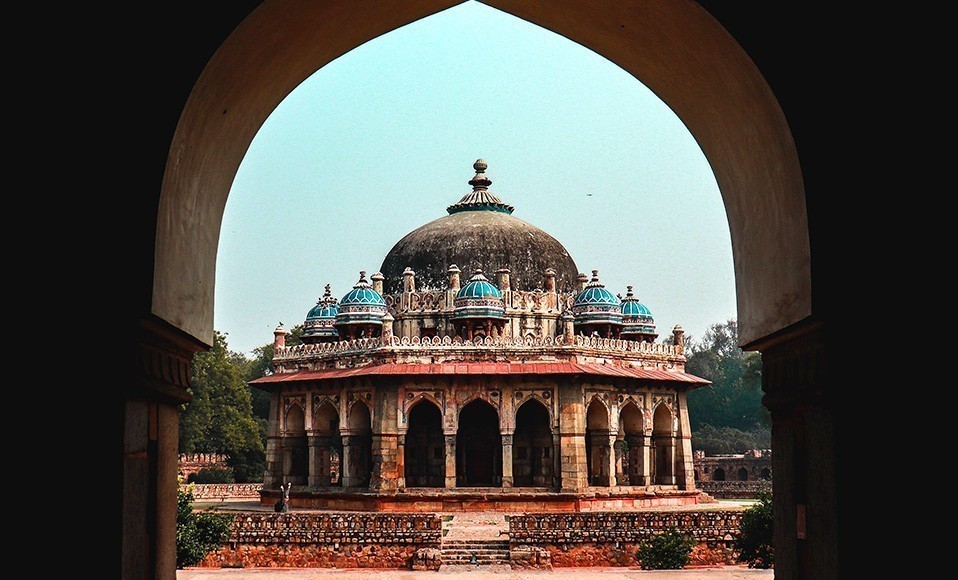
It is the first thing you will see when you enter the complex. As we already know, artists built the Humayun tomb near existing buildings. Govt of India has made one complex of all tombs and mosques. Interestingly, Isa Khan was a noble of Afgan King Shershah Suri. After facing defeat in the battle of Chausa (1539), Humayun went to Persia. As a result, King Shershah Suri started ruling India.
Notably, they built the tomb of Isa Khan in 1547-1548. If I talk about the architecture of the Isa Khan tomb, then it is completely different from any Mughal monument. Importantly, the shape of the tomb is octagonal, and there is one open arches hall and a covered central hall. They used mixed stones to build it. For example, grey and red. The main features are blue tiles on chattris and windows (jalis). Surprisingly, the dome is completely different here, with an octagonal drum.
ISA KHAN TOMB MOSQUE
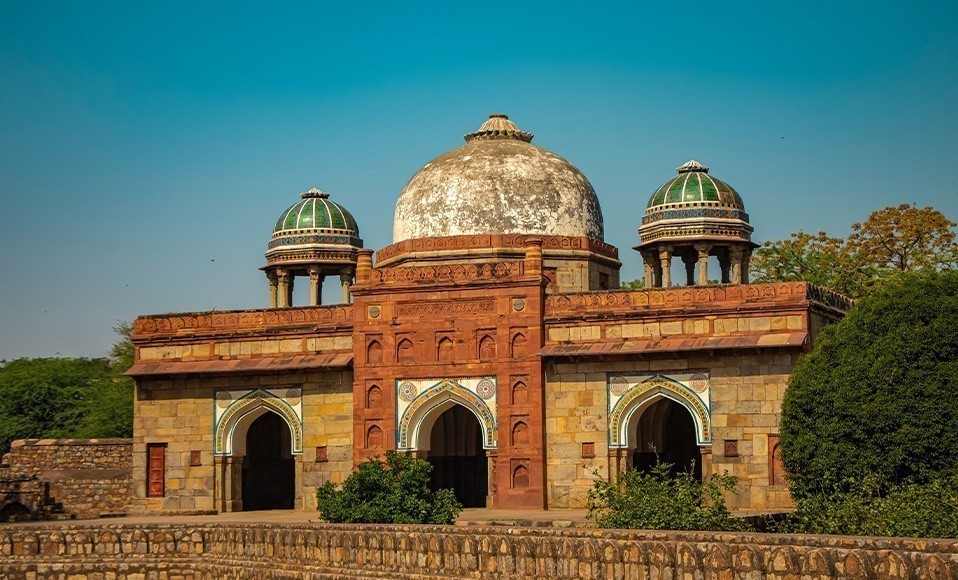
This beautiful Sultanate’s style mosque in Humayun tomb is near the Isa Khan tomb. According to dynasty rules, they always built a mosque in a tomb complex. The Isa Khan mosque is situated on a platform of stones. Interestingly, the mosque has one big dome in the center and two green tiles kiosks around it. Importantly, the tiles they used during those days were natural.
Moreover, there are three arches of the same size with decorated paintings. The facade of the central arch is red and bigger. Surprisingly, it becomes more beautiful from the inside because of its paintings on the roof.
AFSARWALA TOMB AND MOSQUE
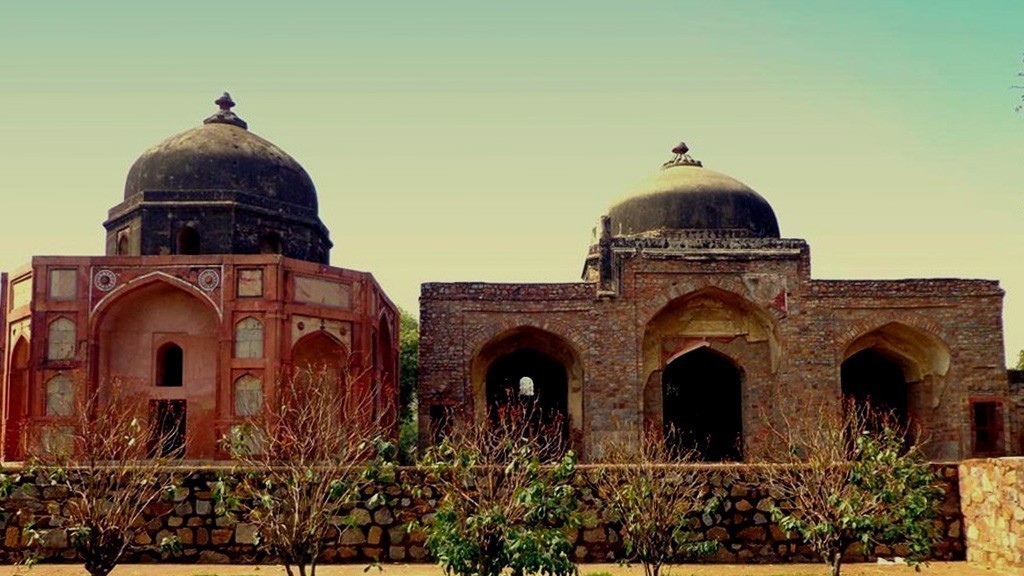
Afsarwala tomb is an unknown tomb of an officer, and hence they started calling it Asfar (officer) tomb. The tomb is located near the west gate of Humayun tomb. There is also a single dome adjoining mosque located on the platform. Interestingly, the tomb is octagonal, and the mosque is rectangular. There are three arches on the facade of the mosque. Undoubtedly, the main feature of the mosque is paintings on the ceiling. Both buildings date back to the (sixteen) 16th century.
NEELA GUMBAD
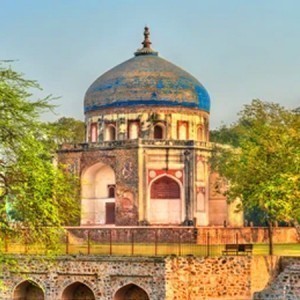
Historians have no idea about the identity of the person in this tomb. Some believe that the tomb belongs to a noble during the Emperor Jahangir period (17th century). Neela gumbad (Blue dome) is near Humayun tomb complex.
Importantly, the main feature of the tomb is the blue tiles on the dome. Undoubtedly, the tile’s decoration came from Persia, but local artists learned to use them. Apart from this, the tomb is octagonal, and the blue dome supports a high drum. You also can find beautiful windows here.
NAI KA GUMBAD (BARBER'S TOMB)
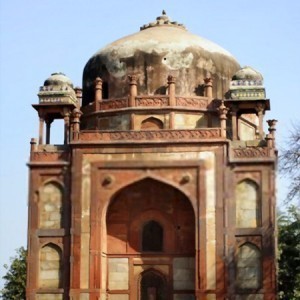
It is hard to believe that a barber can find a resting place near Emperor’s tomb. According to historians, they built a barber’s tomb for Humayun’s favorite barber.
Importantly, the structure’s shape is square, and there is a single dome. There are two graves in the central hall. Apart from this, they used red sandstone to make it beautiful. Moreover, the barber’s job required lots of trust from the Royal family, and we all know his blade was always on the throat of the Emperor during work.
BU HALIMA TOMB
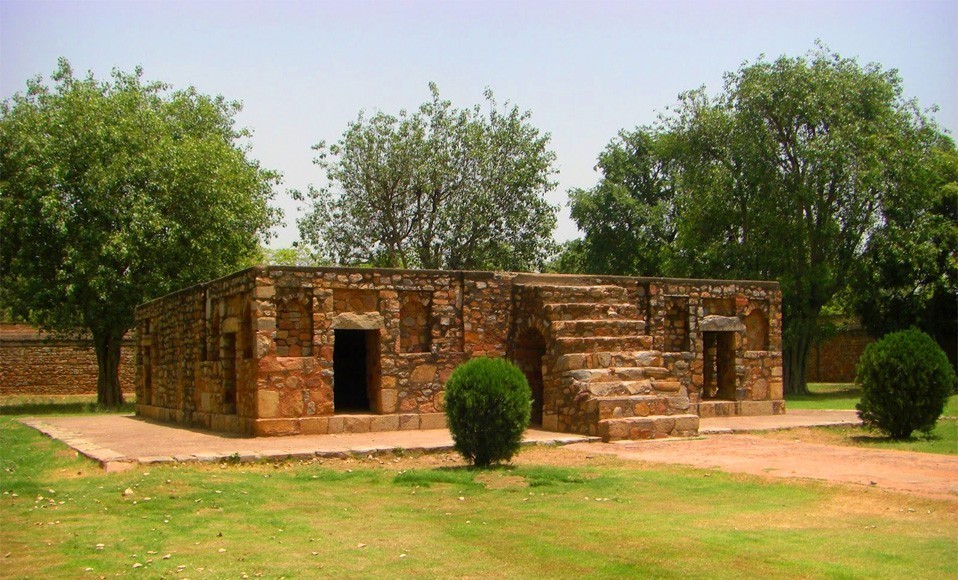
Bu Halima was important women of Mughal harem. Some people believe she was a wet nurse. One can imagine her importance because the tomb is in the main complex of the Humayun tomb. Interestingly, they used stones and mortar (a kind of cement) to build this structure. It is huge and has access to the roof through stairs. It is located right after Isa Khan’s tomb. Apart from this, it has a beautiful gateway (Bu Halima Gate), which leads towards the Main tomb of the emperor.
ARAB SARAI
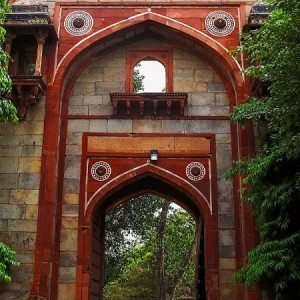 Sarai means Inn or a lodge, and it is located next to Bu Halima’s gate. Haji begum or Hamida Banu Begum, the wife of Humayun, went to Mecca. As we know, Muslims go to Mecca, which is in Arab, to perform Hajj.
Sarai means Inn or a lodge, and it is located next to Bu Halima’s gate. Haji begum or Hamida Banu Begum, the wife of Humayun, went to Mecca. As we know, Muslims go to Mecca, which is in Arab, to perform Hajj.
Interestingly, During coming back from pilgrimage, she brought some Arabian people. As a result, they built this lodge for them, and people called it Arab Sarai. Sadly, only a gateway exists now; the rest has disappeared. Apart from this, the gate has two beautiful chattris and two red sandstone arches.
HUMAYUN TOMB NEAREST METRO STATION?
Violet Line : JUNGPURA AND JNL STADIUM ( 500 METERS)
YELLOW LINE : JOR BAGH (2KM)
PINK LINE : ASHRAM AND Hz NIZAMUDDIN STATION (3KM)
PLACES NEAR HUMAYUN TOMB?
SUNDER NURSERY: This beautiful heritage garden has many tombs and structures of Delhi’s Sultanate. It is on the left of the ticket window of Humayun tomb ( walking distance 2 mins). Interestingly, they recently renovated this huge garden, and there are many canals, rose gardens and beautiful structures.
DARGAH Hz NIZAMUDDIN AND GALIB TOMB: Famous Sufi saint of Delhi Hazrat Nizamuddin’s shire is located across the road. He was living here in the 14th century and helped many poor people. As a result, his followers built a shrine for him. Moreover, you can enjoy Sufi Qawwali every Thursday.
Galib needs no introduction; his Urdu poetry has no match. The tomb of Mirza Galib is located near Shrine.
RAHIM TOMB : Abdul Rahim Khan E Khanam was mughal poet and son of Bairam Khan. Interestingly, he was one of the nine gems of Emperor Akbar. After his death, they built a beautiful tomb for him. Surprisingly, it looks like Humayun’s tomb. Notably, it takes 2 mins drive to reach here from Humayun tomb.
LODHI GARDEN: The green garden is located 10 mins away from the Humayun tomb. There are many toms of Sultanate’s period to watch.
HOW TO GET TO HUMAYUN TOMB?
Humayun tomb is near Mathura road, and the nearest bus stop is Hz Nizamuddin. Notably, you also can take violate line of the Delhi Metro and get off at Jungpura station or JNL stadium.
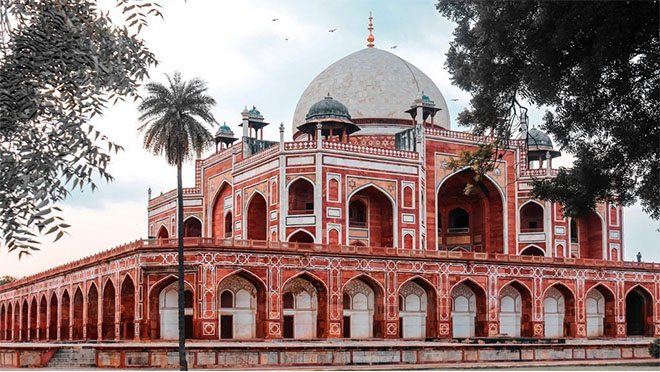
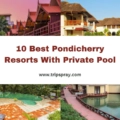


1 Comment